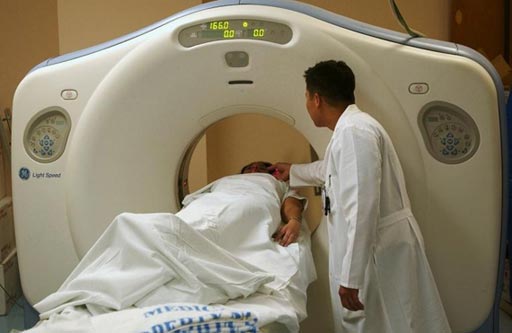CT Scans Help Detect Blunt Injury in Trauma Patients
By MedImaging International staff writers
Posted on 10 Feb 2017
Advances in diagnostic imaging technology over the past 30 years have led to a six-fold increase in blunt cerebrovascular injury (BCVI) detection rates, according to a new study.Posted on 10 Feb 2017
Researchers at the University of Tennessee Health Science Center conducted a study to identify patients with BCVI between 1985 and 2015, who were then stratified by age, gender, and injury severity score (ISS). In all, 564 patients (65% male, mean age 41) were diagnosed with BCVI; 508 with carotid artery and 267 with vertebral artery injuries. BCVI-related stroke and mortality rates were then calculated, and the patients were divided into five eras based on changes in technology, screening, or treatment algorithms.

Image: New research asserts that CT scans can help detect blunt injury in trauma patients (Photo courtesy of GE Healthcare).
The results showed that the percentage of blunt trauma patients diagnosed with BCVI increased from 0.33% to 2% during the study period. However, the percentage of these patients who went on to have a stroke due to the injury declined from 37% to 5% over the same period, and those who died from BCVI declined from 24% to zero. The researchers attribute these results to CT-scanning and its availability in hospitals large and small. The study was published on January 19, 2017, in the Journal of the American College of Surgeons (JACS).
“Clearly the advances in CT-scanning technology that developed since the first CT scanners came out to being able to do CT angiography, which is really a noninvasive form of angiography, have significantly improved diagnosis,” said lead author Louis Magnotti, MD, of the UTHSC department of surgery. “It is important to not get bogged down in managing or treating or diagnosing patients the same way as times change. Even though you may have had good results, you should always look to do better.”
“Not every hospital is going to have access to digital subtraction angiography, which needs to be performed by an interventional radiologist or vascular surgeon or neuro-interventionist, but the majority of hospitals, even small hospitals, have CT-scanning ability,” concluded Dr. Magnotti. “They can diagnose these injuries on the front end, and even if they cannot treat them, they can at least refer these patients to centers that can treat them.”
BCVI is primarily caused by longitudinal stretching and injury to the carotid or vertebral vessels. Motor vehicle accidents (MVA) resulting in acceleration-deceleration can cause rotation and hyperextension of the neck, stressing the craniocervical vessels, the mechanism for the most common cause of BCVI. A direct blow to the neck or base of the skull may injury the carotid or vertebral arteries. BCVI is diagnosed in approximately 0.1% of patients hospitalized for trauma in the United States, unless a screening program has been initiated. Most cases are diagnosed following development of symptoms secondary to central nervous system ischemia, with a resultant neurologic morbidity of up to 80% and associated mortality of up to 40%.














